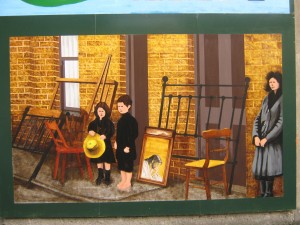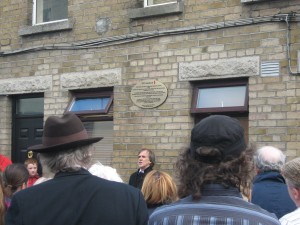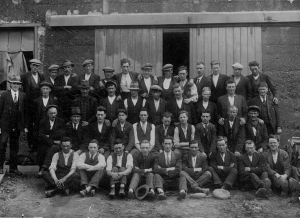1913 Lockout Merchants Road Evictions Images may fade, but our memories should not
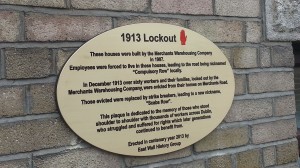 During the 1913 Lockout over sixty East Wall families were evicted by the Merchants Warehousing Company. The photograph above is a particularly
During the 1913 Lockout over sixty East Wall families were evicted by the Merchants Warehousing Company. The photograph above is a particularly 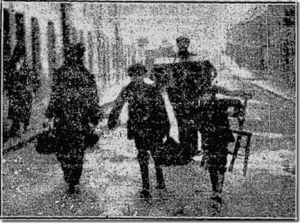 haunting image, showing an evicted family carrying their possessions along Merchants Road. The other two photographs, while not as poignant, also illustrate the events of that day. The first shows bailiffs gathered at a door about to serve an ejectment notice on a family, while the second is evicted residents with their furniture placed in front of their former home.
haunting image, showing an evicted family carrying their possessions along Merchants Road. The other two photographs, while not as poignant, also illustrate the events of that day. The first shows bailiffs gathered at a door about to serve an ejectment notice on a family, while the second is evicted residents with their furniture placed in front of their former home.
The quality of these images is poor; however, as no other copies are currently available to us we feel that they are of such historical importance that they should be published.
Images can fade, but memories should not. Next Sunday,15thSeptember a commemorative event to remember the families evicted during the 1913 Lockout is taking place – an impressive new mural depicting an eviction scene along with a plaque on the Merchants houses will be unveiled.
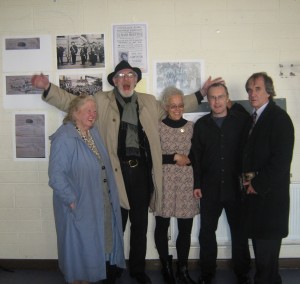
Mae Mac Giolla, Jer O’Leary, Sarah Lundberg, Joe Mooney and James Connolly Heron at Event Evictions commemoration
For More Pictures see www.Eastwallforall.
Waiting for the Bailiffs
This coming weekend, on Sunday 15th September, a major commemoration of East Walls Lockout evictions is taking place. Sixty two workers and their families were evicted from company owned houses on Merchants Road, in what we believe to be the single largest eviction in the history of Dublin City. An examination of the 1911 census shows many of the Merchants Road households recorded at that time had at five or more persons living in them, meaning that it is likely that 250 to 300 men, women and children were made homeless by this eviction, or possibly slightly higher.
The East Wall History Group has used the 1911 census, the Wharf school records and St. Laurence O’Tooles parish records to help identify those evicted, as well as family memories. Amongst those who suffered were the ancestors of Tommy Dunne who were living at number 38 Merchants Road. The household included Tommy’s grandparents, Michael and Teresa, and his father Thomas. In this exclusive extract from the forthcoming book “The Legacy of the Lockout” (to be published November 2013), Tommy is interviewed about his family plight.
The houses on Merchants Road were built by the Merchants Warehousing Company, adjacent to their East Wall premises as compulsory housing for their employees. In December of 1913 over sixty workers families were evicted, and their homes handed over to strike-breakers. The family of Tommy Dunne was amongst those evicted, his own father being only one year old at the time:
My Father talked to me about his Father, having a cottage in the Merchants, and they lost it in the ’13 strike, you know. He told me that he was the third man into Larkin’s Union, and he was in Larkin’s band. They called them ‘the sufferin ducks’ I think. That was just a nickname, obviously it was, and when he was born in 1912 his mother said the sufferin ducks played outside the cottage. And after that, when the ’13 strike came, obviously my father was only one years of age, he doesn’t remember it. Seemingly they were all locked out, they lost their cottage, which was a very big thing to lose at the time …my own father said, he thinks he was mad , to lose everything, it was a lot to lose at the time . In the end they ended up in Empress Place, which is across the road somewhere, not far, and after that in Summerhill, the tenements, where I was born.
Tommy’s Grandparents had come to Dublin from Kildare and Kilkenny respectively. They had been married in Westland Row Church before finding both employment and housing in East Wall. (They lived in number 8 St.Marys Road prior to Merchants Rd)
I take it they were in digs of some sort before they got that. He was interested in horses you see; maybe a lot of people were in them times, as it was the main mode of transport. He got a job in the merchants through all that, through knowing about horses and stuff like that.
The loss of their source of income and home was a serious consequence for the Dunne family, and they were not prepared to forgive and forget, even years and decades later:
My Grandmother … she was in Summerhill, now she was political , she was in demonstrations , she was taken away from demonstrations by the police as well , a couple of times …She seen a fella comin’ along in an IRA uniform , and I think his name was Towsen . And she got on to him, and said he was a scab, that he’d taken the cottage, and he had an argument with her. And the IRA came down to see her, you know, and she had a talk, a long talk with them, but the story is that they went back and discharged him from the IRA. This is what I was told, I don’t know any more than that really.
And Tommy’s own father was to make a return visit to the former family home in the 1950’s:
Oh yeah , he actually went to one of the cottages , in his 40’s, I know that , and he said that cottage belonged to his father , and the people that were living there were scabs , (laughs), he actually went there , he worked for the corporation , and he was working down there, and he knocked on the door and he said it to them, the people there , who probably didn’t know, the descendents , probably didn’t know what happened , what the history was , you know . It probably didn’t have the effect he probably thought it would…. He was bitter about it when he was younger.
Crowes Timber Yard, East Road 1930
Tommy Dunne’s grandfather afterwards found employment in Crowes timber-yard, very close to his former home and workplace. Also working here were men who had scabbed during the Lockout
… and obviously in the Merchants afterwards, the whole lot .When people are hungry they’ll turn to anything I suppose, the poor people. It’s easy for the richer people to take their pick.
William Martin Murphy had recognised this when he informed the Dublin Chamber of Commerce:
‘The employer all the time managed to get his three meals a day, but the unfortunate workman and his family had no resources whatever except submission , and that is what occurred in 99 cases out of 100. The difficulty of teaching that lesson to the workman was extraordinary’
Tommy’s father also worked in Crowes, starting in the mid 1920’s:
It must have been bad at that time. My father used to say , there was a dozen men , whatever , walking up and down outside of Crowes , on the front , and you daren’t do anything wrong , because they were like fresh horses….they were like fresh horses just waiting for the old horses to die , and out they go , if they done anything wrong , and they’d just walk in, you know . So going back in time again, at the time of the Merchants it must be really bad you know. People were depending on anything, I’d say.
From Wharf School registers 1910
Also amongst those evicted were the Coombes family, living at number 61 Merchants Road. Richard Coombes was a labourer in the company, having moved in from Tallaght. He lived on the Merchants with his wife Julia and their four children aged 6 years to 15 years. Following the eviction, they were amongst a number of families that stayed for a short time in tents erected for them on the East Wall Road. After a few days they were offered a room with a family at number 5 St. Marys Road, (believed to be named Hanna or Hannon). They afterwards moved to Newfoundland Street (North Wall), to what a family member recalls as ‘a white -wash cottage’, which she remembers being demolished in the 1930’s.
Following the Lockout, many workers were able to return to their former employment. Richard was not amongst them, and never worked for the Merchants Warehousing Company again. He later found employment in the Liffey Dockyard, as did his four sons. Billie & Richie were labourers, while Larry was a Caulker and Georgie a Rivet Boy.
Some of Richard Coombes grand children, great grand-children, and other relatives continue to live in the East Wall area –his granddaughter Anna Kearney on Seaview Avenue, grand son Richard on St. Marys Road and great grand children Tréasa Woods on St.Marys Road, Ita Hulton on Caladon Road and Terry Coombes on Bargey Road .
Descendants of the Dunne and Coombes families, evicted in 1913 will be amongst those taking part in the unveiling ceremony on Sunday.
Commemoration of East Wall evictions
Sunday 15th September 2.30pm
Assemble: St. Josephs Co-Ed School, East Wall Road
All welcome
“The Legacy of the Lockout” extract courtesy of 1913 Alternative Visions Oral History project, used with permission.
Waiting for the Bailiffs image courtesy Hugo McGuinness
Stables in Merchants Warehousing image courtesy Curtis Collection /East Wall History Group
Crowes workers image courtesy of Tommy Dunne (family collection)

